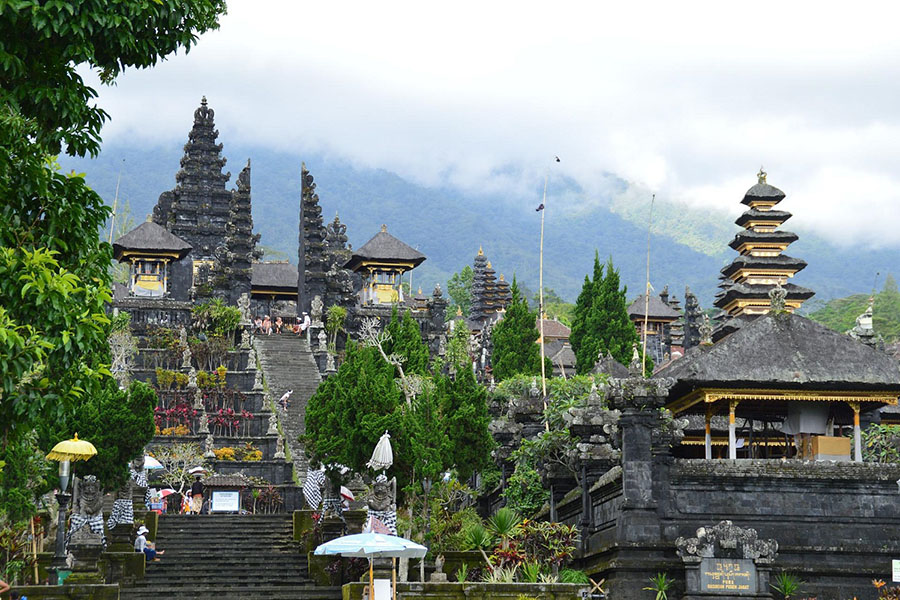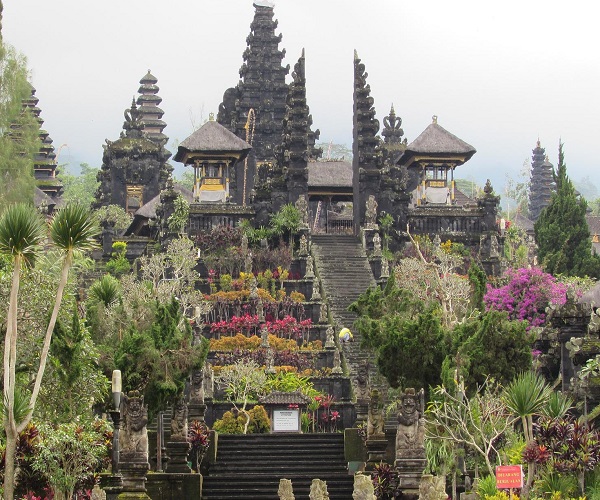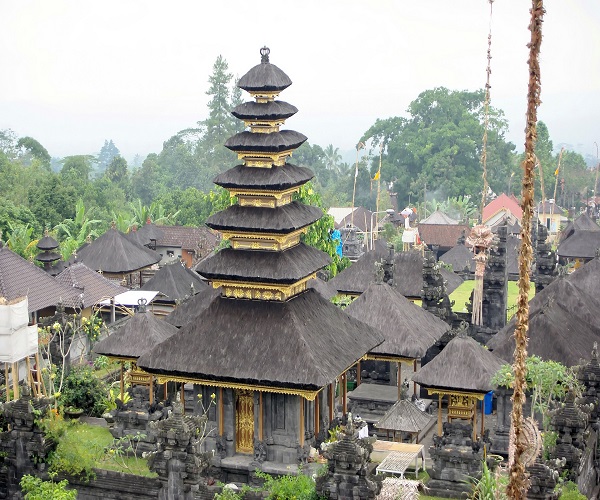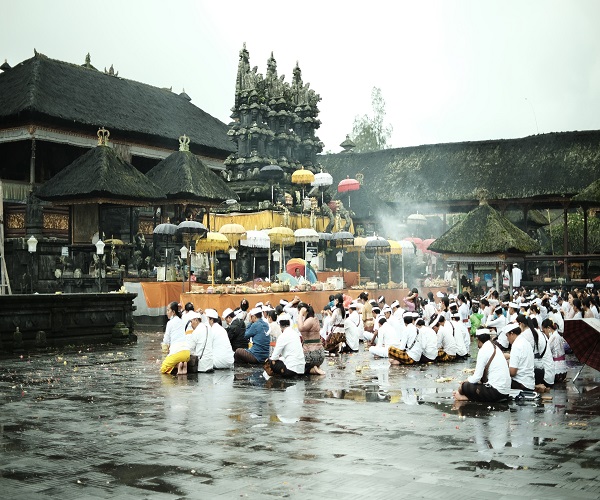BALI BESAKIH TEMPLE
BALI BESAKIH TEMPLE IS THE BIGGEST HINDU TEMPLE AND ALSO AS A MOTHER TEMPLES IN THE ISLAND OF BALI

Bali Besakih Temple is the largest Hindu temple on Bali Island, known as Pura Besakih by the locals. This temple has a beautiful view from its top, where you can enjoy a wide panorama of nature and the ocean. Because of its beauty, Besakih Temple is often visited by tourists from various parts of the world. Besakih Temple is located in Besakih Village, Rendang District, Karangasem Regency, in the eastern part of Bali Island. The temple is on the southwest side of Mount Agung, the highest and most sacred mountain in Bali, according to local beliefs. As the largest temple on Bali Island, Besakih Temple is always crowded with tourists who are attracted by its uniqueness and majesty. If you are fond of religious tours, then a visit to Besakih Temple is the right choice. Here, you can see a row of temples that are always crowded with pilgrims who come to pray.
If you visit Besakih Temple, here’s what you need to know:
- Mother Temple of Bali
- Besakih Temple History
- Meaning Name of Besakih
- Basukihan Temple at Besakih Temple
- Panca Dewata Besakih Temple
- Besakih Temple Geographically
- Besakih Temple Location
- Besakih Temple Dress Code
- Besakih Temple Facilities
Mother Temple of Bali
Besakih Temple is called the mother of Bali’s temples because its complex is very large and spacious and consists of many smaller temples within it. This makes Besakih Temple one of the largest temples and has the largest number of temples in its complex, so it is considered the mother of all temples on the island of Bali. This temple, or what is referred to as the “Mother Temple” in Bali, is located more than 900 meters up the slope of Mount Agung. Besakih Temple has been considered sacred since pre-historic times in Bali, with the first written record dating back to an inscription in 1007 AD. Since the time of the Gelgel dynasty in the 15th century, Besakih Temple has been considered the center of sacred temples throughout Bali. Balinese people from different districts and caste groups gather at Besakih Temple, with a total of 18 separate shrines within the complex. The three main temples in Besakih Temple are: Penataran Agung Temple, dedicated to Sang Hyang Widi Wasa. Kiduling Kreteg Temple, dedicated to Brahma, and Batu Madeg Temple, dedicated to Vishnu. For the Balinese, visiting the sacred temples at Besakih Temple is a special pilgrimage. Each temple has its own anniversary celebrated with odalan festivities, and on the full moon of “Kedasa” in the Balinese calendar, the entire Besakih temple complex celebrates the visit of the gods with an overwhelming crowd of pilgrims.
Besakih Temple History
The history of Besakih Temple has several versions that are told, considering that this temple is classified as very old, so it still requires further research. The Besakih Temple complex has many artifacts from the megalithic era, such as menhirs, stone thrones, and stepped terrace structures, which indicate the age of the Besakih Temple is from a very old era, long before Hinduism influenced this area. From the stories circulating and the research available, several versions of Besakih’s history can be presented.
-
Besakih Temple History Based on Rsi Markandeya
The history of Besakih Temple, according to the story of Rsi Markandeya, began in 1284, when a Rsi of Indian descent named Rsi Markandeya (a religious leader) was meditating on the Dieng plateau. At that time, he received a revelation to build the Besakih Temple. Rsi Markandeya then traveled to Bali through the forests of Java. According to the story, he came to Bali through Segara Rupek (Bali Strait) with 8000 followers, heading for Mount Toh Langkir (now Mount Agung). They cleared the forest to open agricultural land, but the mission failed as many of his followers died from various causes such as illness, mysterious events, and wild animal attacks. Rsi Markandeya realized that there was a mysterious force or aura that controlled the island. After returning to Mount Dieng to meditate and ask for further instructions, Rsi Markandeya received a revelation to bring 400 people from the Aga village, the inhabitants of the foot of Mount Raung. Before starting work, they performed ritual ceremonies such as mecaru and planted the five metal elements, or Panca Datu, namely gold, silver, copper, bronze, and iron, accompanied by Mirah Adi (the main gem), to ensure safety in carrying out work in the forest on the slopes of Mount Suci. As a result, there were no more disasters when they encroached on the forest. This may be the basis for the practice of Hindus today, who always perform yadnya ceremonies before clearing new land, whether for houses, rice fields, or gardens, as well as for temples, by planting Panca Datu metal, which symbolizes the five elements.
After that, Rsi Markandeya distributed land to his followers to be used for rice fields, plantations, and houses. When he was on Mount Toh Langkir (Mount Agung), he realized that Dawa Island (now Bali) was not that big. Therefore, he replaced it with the name Pulau Wali, which comes from the South Indian Palawa language, meaning holy offerings. This is related to the tradition of offerings or holy ceremonies performed by Hindus in temples during prayers.
After that, the Toh Langkir area developed by him was named Besuki, which later changed to Basuki, meaning safe. The place where Rsi Markandeya performed the offering ceremony and planted the 5 metal elements (Panca Datu) is known as Pura Besakih. Initially only a pelinggih, then developed into a temple called Besukian, and then continued to grow, the construction was carried out in stages to become the largest temple complex now known as Pura Besakih.
-
Besakih Temple History Based on Sri Kesari Warmadewa
The history of Besakih Temple, according to Sri Kesari Warmadewa, records that he was the founder of the Warmadewa dynasty that ruled Bali for several centuries. Sri Kesari Warmadewa is also believed to be the first founder of the temple complex at Besakih. This can be seen from the 914 AD Belanjong pillar (Blanjong Inscription) in the south of Sanur, the Penempahan inscription, and the Malet Gede inscription (835 Saka), which tells us that Sri Kesari was a Buddhist king of the Syailendra dynasty. He led a military expedition and established a dynasty in Bali. These three inscriptions indicate a connection between Bali and the Sanjaya Dynasty in Central Java.
This is the dates according to the Indian Saka calendar. Another interesting point is that the three inscriptions mostly describe King Sri Kesari’s victories in battle against his enemies. Although the inscriptions are outdated, only two enemies can be identified, namely at Gurun and Suwal, although the exact locations remain unclear. Some scholars suggest that Gurun may be the same as present-day Lombok, while others suggest that Gurun may be the same as Nusa Penida.
Sri Kesari Warmadewa was famous for his devotion to worshiping the gods that reside on Mount Agung. His place of worship is called Merajan Selonding, or Merajan Kesari Warmadewa. He also expanded the originally modest Penataran Agung Besakih Temple and built various temples in Besakih to complement the pre-existing sacred buildings. These include Gelap Temple to worship Lord Iswara, Kiduling Kreteg Temple for Lord Brahma, Ulun Kulkul Temple for Lord Mahadeva, Batumadeg Temple for Lord Vishnu, Dalem Puri Temple for Goddess Durga, and Basukihan Temple to honor Naga Basukihan. Sri Kesari was also the one who ordered Hindus to celebrate Nyepi on Sasih Kesanga.
 |
 |
 |
Meaning Name of Besakih
The name Besakih comes from the word Basuki, which is an ancient form of Sanskrit Wasuki and was later used in Old Javanese. In Sanskrit, Basuki means “safe”. According to Samudramanthana mythology, Basuki is the name of a dragon that circles Mount Mandara. This origin is linked to megalithic traditions that signaled the importance of the place to be sanctified. It seems that Besakih Temple has a very old history, long before the introduction of Hindu influence. Later, an ancient Balinese king named Sri Kesari Warmadewa discovered the Merajan Selonding Temple in the Besakih Temple complex. He also ordered the construction of the Blanjong Monument, located in Sanur Village. The Besakih Temple complex was established with an attention to the balance of the cosmos, which is related to the concept of nature organizing the base of the temple complex according to the direction of the road. As a result, these buildings are considered to represent nature as a symbol of world balance.
Basukihan Temple at Besakih Temple
Besakih Temple is not just one temple, but a temple complex consisting of many other temples underneath, making it the largest temple on Bali Island. Among these temples, there is the Panca Dewata Temple that guards the cardinal directions, as well as the main temple known as Basukihan Temple, or better known as Besakih Temple. It is located at the foot of the Penataran Agung Besakih Temple, to the right if we climb the steps of the Penataran Agung Temple. Basukihan Temple has a main pelinggih in the form of meru tumpang pitu (level seven) and is considered the main temple in the Besakih complex. According to sources from the Sulinggih there, Danghyang Markandeya planted Pancadatu Pedagingan (five types of metal with complete rituals) in Basukihan Temple, Penataran Agung Temple, and Dalem Puri Temple, which is considered the mother of Kahyangan. In addition, there are three temples in the surrounding villages, namely Desa Temple, Puseh Temple, and Dalem Temple.
The state-of-the-art equipment present in each temple, together with religious literature related to temple construction procedures, shows that Basukihan Temple acts as Puseh Jagat temple, Penataran Agung Temple as Desa Jagat temple, and Dalem Puri Temple as Dalem Jagat temple. In this context, Basukihan Temple, Penataran Agung Temple, and Dalem Puri Temple are considered as the centers, while other temples such as Desa Temple, Puseh Temple, and Dalem Temple are scattered around them. Thus, as a whole, Besakih Temple is considered as the temple of Penyungsung Jagat. Hyang Naga Basuki is worshiped in this temple, and Piodalan Day is celebrated on Buda Wage Kelawu or Budha Cemeng Kelawu.
Panca Dewata Besakih Temple
Panca Dewata here refers to the gods who reside in each cardinal direction with the aim of protecting the universe from all directions, such as East, South, West, North, and Center, which have their respective roles and functions. Panca Dewata is the manifestation of Lord Shiva, who is responsible for the protection of the cardinal directions throughout the universe, and Penataran Agung Temple is the center point. The following is an explanation of the temples in Besakih Temple that are part of Panca Dewata as the guardian of the cardinal directions in Besakih Temple, which consists of 5 temples with different functions and roles according to the cardinal directions.
- East: Gelap Temple is located in the east and plays a role in worshiping God in his form as Bhatara Iswara, who is in charge of guarding the eastern direction of the universe, or Bhuwana Agung. Although called ” gelap”, the word does not refer to actual darkness, but rather comes from the ancient Balinese language, the Kawi language, which means lightning or thunder with bright white light. Gelap Temple is a place of worship for God in the form of Dewa Iswara, who is the god of light. Life on earth is possible because of the sun. Sunlight is the main natural resource that gives life to all creatures in nature. Gelap Temple is one of the important elements in the temple complex that guards the eastern cardinal directions.
- South: Kiduling Kreteg Temple is located in the south and serves as a place of worship for God in his manifestation as Bhatara Brahma. This temple is in charge of guarding the southern direction of the universe, and the name Kiduling kreteg is taken from the ancient Balinese language, which means “next to the bridge”, according to its location adjacent to the bridge of Penataran Besakih Temple. One of the purposes of worshiping God as Lord Brahma at Kiduling Kreteg Temple is to guide Hindus to always develop creativity in realizing the teachings of the Vedas in personal and social life, as well as maintaining the spirit of life to always be in the order of Dharma. This is symbolized in Pelinggih Meru Tumpang Sebelas, located in the northeast corner of the Kiduling Kreteg Temple area, often referred to as Ratu Cili’s Palace by the locals.
- West: Ulun Kulkul Temple is located in the west and serves as a place of worship for God, who appears as Hyang Mahadeva, who is in charge of guarding the west, and has a large kulkul, or drum, inside. This temple was founded during the reign of King Sri Kesari Warmadewa, around 835 AD. Originally, this place was the location of Kulkul (Kentongan). Because there is a large kentongan in this temple made of silingui wood, it is believed to be the origin of kulkul in Bali. Based on this belief, every village that makes Kulkul for Kahyangan Tiga temple or a temple recognized by the community, when the release asks for tirta at Ulun Kulkul. In addition, during the reign of King Sri Kesari Warmadewa, Ulun Kulkul Temple was considered as a place to give birth to justice, and officials at that time were appointed in this temple.
- North: Batumadeg Temple is located to the north of Penataran Besakih Temple and is one of the important temples of the Besakih Temple complex. The area of Batumadeg Temple is vast and contains many temples. Based on its structure, the temple is believed to date back to the megalithic era, as evidenced by the presence of a large stone in the Meru temple. The name “Batumadeg” refers to an upright stone in Balinese, which means standing upright, which in an archaeological context is called a menhir. The madeg stone is a symbol of the worship of Bathara Ida Ratu Saktu Watu Madeg, the manifestation of Ida Bhatara Vishnu in the Siwa Pasu Pata worship system. The menhir is placed in Meru Tumpang Solas but cannot be seen directly because it is inside the temple.
- Center: Penataran Besakih Temple, located in the center of the Besakih temple complex, which is the largest and most important of all the temples there. Its function is to worship God in his manifestation as Lord Shiva. Of all the temples in the Besakih temple complex, Penataran Agung Temple is the largest and has the most temple buildings, as well as hosting a wide variety of ceremonies. This temple is considered the center of the entire Besakih temple complex. In the King Purana of Besakih, it is mentioned that the Great Penataran Temple of Besakih is the place of Pesamuaning Batara Kabeh, which shows the importance of this temple in the Hindu tradition in Bali. One of the characteristics of Penataran Agung Temple is the presence of Padma Tiga, which symbolizes the worship of Tri Purusa, namely Lord Shiva, Lord Sada Shiva, and Lord Parama Shiva. In addition, this temple also has a bale pawedaan as a place of worship for the sulinggih, as well as a bale agung, which is where the walaka and sulinggih paruman conduct religious activities.
Besakih Temple Geographically
Besakih Temple, which is the largest temple on Bali Island, is built on an area of 20 hectares in Rendang village, Karangasem, Bali. In this area, the Besakih Temple complex has 46 large and small temples. The temples are divided into three parts, namely Penyungsungan Jagat Temple with 20 temples, Kawitan Temple, which contains 17 temples, and Dadya Temple, which has 9 temples. Among all these complexes, Penataran Agung Temple is the center and the largest temple in the area. Penataran Agung Temple has seven levels and is decorated with statues of the three main deities, namely Lord Brahma, Vishnu, and Shiva. In the Besakih Temple area, you can also see stone-age relics such as stone thrones and menhirs. The architecture of this temple building has a philosophy with oddly stacked roofs, such as 1, 3, 5, 7, 9, and 11, which symbolize prosperity. The temple complex also has several stepped pundens connected by about 800 steps. Although the journey to Besakih Temple can be tiring at times, the beauty of this temple complex and the fresh air at the foot of the mountain will provide an unforgettable experience.
Besakih Temple Location
Besakih Temple is located in the eastern part of Bali, close to Mount Agung. To reach this location, it takes about 2 hours to drive, with 2 routes to choose from. The first route is through Kintamani Village, where you will pass the road directly to Besakih. The second route can be taken from Klungkung Village, through Kerta Gosa. You can use Google Maps to easily locate Besakih Temple. At every intersection, there are directions that lead to this temple. If you are confused or want a more comfortable trip, you can contact us at Bali Exotic Tour to be escorted to the location of Besakih Temple. With affordable transportation prices and accompanied by friendly Balinese drivers, the journey to Besakih Temple will be very enjoyable. Don’t miss the opportunity to visit the largest temple on Bali Island while on vacation there.
Besakih Temple Dress Code
To visit Besakih Temple, one of the most sacred and largest temples on Bali Island, it is highly recommended to dress modestly and not wear revealing clothes. This is to respect the Hindus who will be praying there. When visiting Besakih Temple, you will be provided with a kamen (sarong) and shawl that you can wear. This facility is included in the entrance ticket price of Besakih Temple, so you don’t have to worry about bringing kamen and shawls from your place. By wearing the provided kamen and shawl, you are not only respecting the customs and traditions when visiting this sacred temple but also respecting the Hindus who perform prayers there. Therefore, it is important to wear modest clothing and not to dress in revealing clothes when visiting Besakih Temple. If you are interested in the spiritual history of Bali, it is very good to visit Besakih Temple, which is one of the largest and most famous temples in the country.
Besakih Temple Facilities
As a tourist destination and a very popular Karangasem places of interest in the eastern region, Besakih Temple offers very complete facilities. Starting from the large parking lot, which can accommodate many cars and buses, you don’t have to worry about a lack of parking space when visiting here. In the parking area, there are many small stalls selling snacks and drinks, perfect for those of you who want to quench your thirst while here. In addition, there are also toilet facilities that you can use comfortably. Other key facilities that support visitor convenience at Besakih Temple include ticket counters and other facilities available around the Besakih area. With these complete facilities, your visit to Besakih Temple in Bali will be a very pleasant experience. You can learn about the history of the oldest and largest temple on Bali Island, as well as explore the many temples within the Besakih Temple complex. So, enjoy your day exploring the beauty and uniqueness of this temple.

